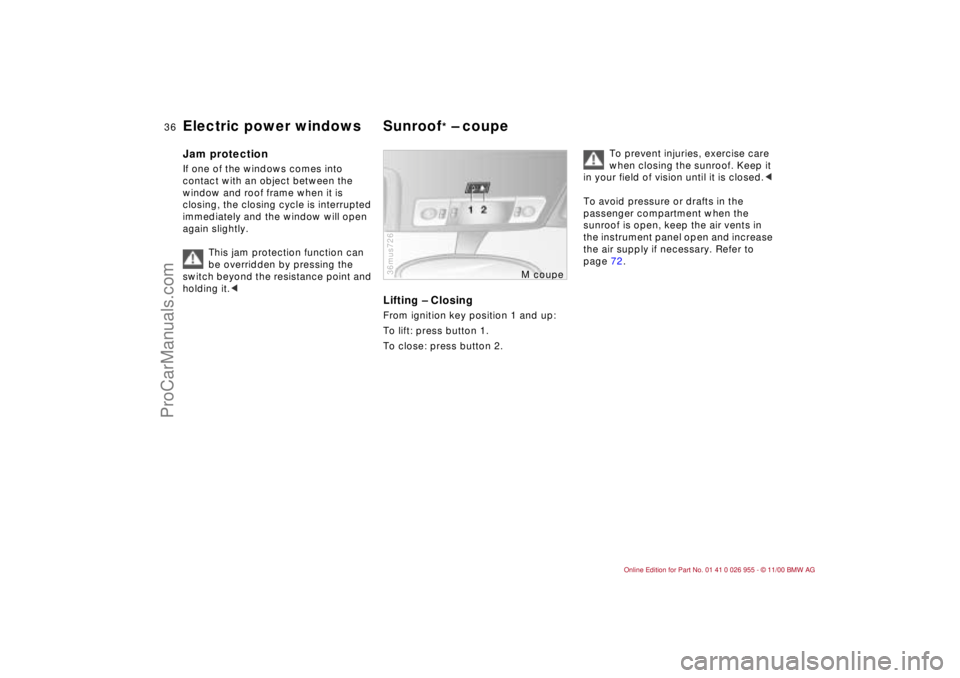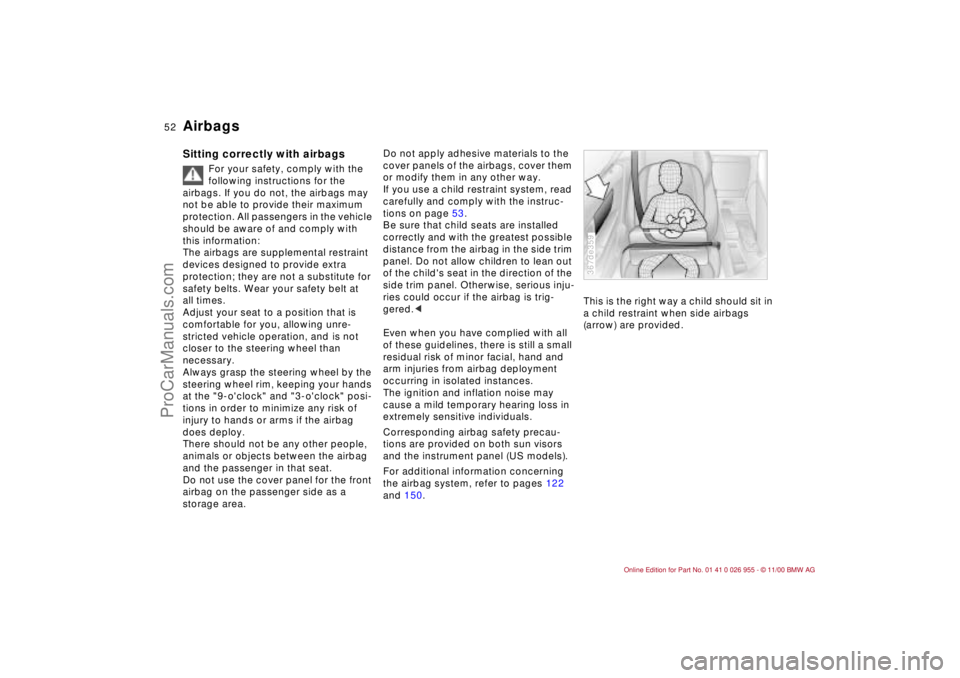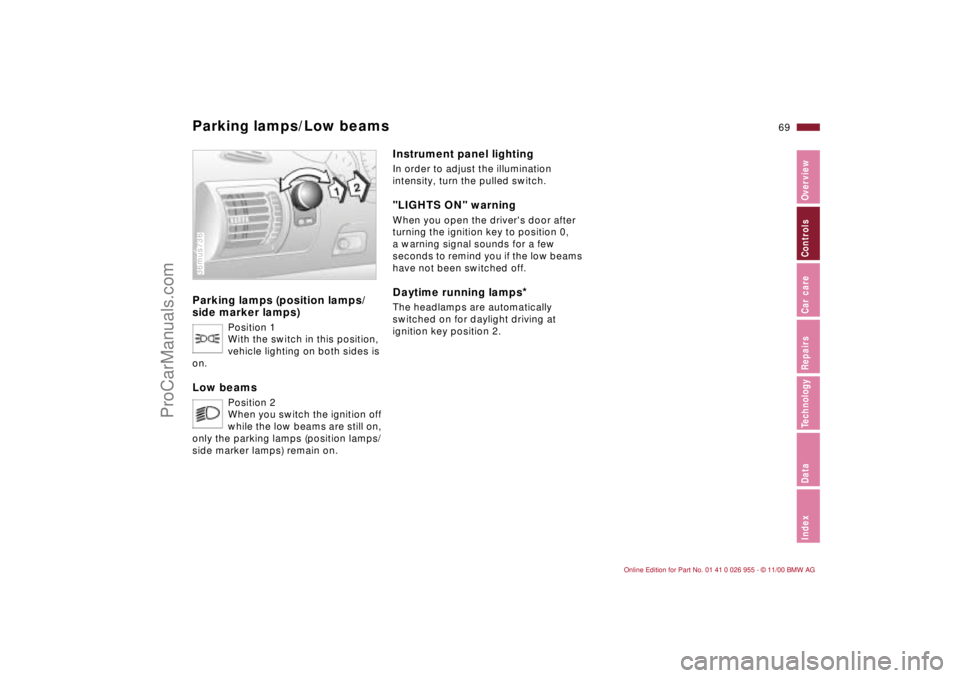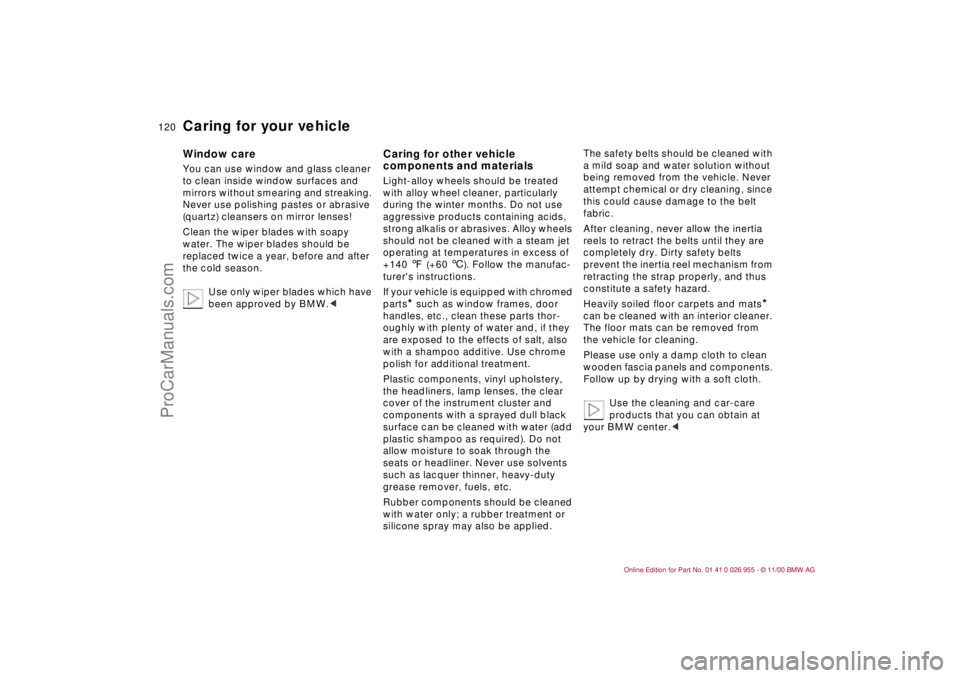2001 BMW M ROADSTER COUPE instrument panel
[x] Cancel search: instrument panelPage 36 of 171

36n
Electric power windows Sunroof
* – coupe
Jam protectionIf one of the windows comes into
contact with an object between the
window and roof frame when it is
closing, the closing cycle is interrupted
immediately and the window will open
again slightly.
This jam protection function can
be overridden by pressing the
switch beyond the resistance point and
holding it.<
Lifting – ClosingFrom ignition key position 1 and up:
To lift: press button 1.
To close: press button 2.36mus726
M cou
pe
To prevent injuries, exercise care
when closing the sunroof. Keep it
in your field of vision until it is closed.<
To avoid pressure or drafts in the
passenger compartment when the
sunroof is open, keep the air vents in
the instrument panel open and increase
the air supply if necessary. Refer to
page 72.
ProCarManuals.com
Page 46 of 171

46n
For maximum safety, please comply
with the following:
Never try to adjust your seat while
operating the vehicle. The seat
could respond with an unexpected
movement, and the ensuing loss of
vehicle control could result in an acci-
dent.
Be sure that the safety belt is fastened
firmly against your body at all times. In
the event of a frontal impact, a loose lap
belt could slide over your hips, leading
to abdominal injury. In addition, the
safety belt's restraint effectiveness is
reduced if the belt is worn loosely.
When adjusting your seat, select a
position that provides the maximum
distance between you and the steering
wheel, instrument panel and door while
still allowing comfortable and safe
access to all vehicle controls.<
Correct sitting postureTo reduce strain on your spinal column,
sit all the way back in the seat and rest
your back fully against the backrest.
In the ideal sitting posture, your head
extends along a straight line from your
spine.
For long-distance driving, you may wish
to increase the backrest tilt angle
slightly to reduce muscular tension.
You should also be able to grasp the
highest point of the steering wheel with
your arms slightly bent.
After a seat adjustment in the coupe,
adjust the height of the safety belt also.
Refer to page 49.1 Height
*
2 Backward/Forward adjustment367de015
Seat adjustment
ProCarManuals.com
Page 52 of 171

52n
AirbagsSitting correctly with airbags
For your safety, comply with the
following instructions for the
airbags. If you do not, the airbags may
not be able to provide their maximum
protection. All passengers in the vehicle
should be aware of and comply with
this information:
The airbags are supplemental restraint
devices designed to provide extra
protection; they are not a substitute for
safety belts. Wear your safety belt at
all times.
Adjust your seat to a position that is
comfortable for you, allowing unre-
stricted vehicle operation, and is not
closer to the steering wheel than
necessary.
Always grasp the steering wheel by the
steering wheel rim, keeping your hands
at the "9-o'clock" and "3-o'clock" posi-
tions in order to minimize any risk of
injury to hands or arms if the airbag
does deploy.
There should not be any other people,
animals or objects between the airbag
and the passenger in that seat.
Do not use the cover panel for the front
airbag on the passenger side as a
storage area.
Do not apply adhesive materials to the
cover panels of the airbags, cover them
or modify them in any other way.
If you use a child restraint system, read
carefully and comply with the instruc-
tions on page 53.
Be sure that child seats are installed
correctly and with the greatest possible
distance from the airbag in the side trim
panel. Do not allow children to lean out
of the child's seat in the direction of the
side trim panel. Otherwise, serious inju-
ries could occur if the airbag is trig-
gered.<
Even when you have complied with all
of these guidelines, there is still a small
residual risk of minor facial, hand and
arm injuries from airbag deployment
occurring in isolated instances.
The ignition and inflation noise may
cause a mild temporary hearing loss in
extremely sensitive individuals.
Corresponding airbag safety precau-
tions are provided on both sun visors
and the instrument panel (US models).
For additional information concerning
the airbag system, refer to pages 122
and 150.This is the right way a child should sit in
a child restraint when side airbags
(arrow) are provided.
367de359
ProCarManuals.com
Page 53 of 171

53n
IndexDataTechnologyRepairsCar careControlsOverview
Airbags Transporting children safely This is the correct way a larger child
should sit wearing the safety belt when
side airbags (arrow) are provided.367de360
Before installing any child restraint
system or child seat, please read
the following:
Never install a rear-facing child restraint
system in the passenger seat of this
vehicle.
If the airbag deploys and hits the back-
rest of the rear-facing child seat, it is
likely that the child sitting in the rear-
facing child seat will be seriously
injured or killed.
If it is necessary for a child (not an
infant) to ride in the vehicle, certain
precautions should be taken. First,
move the passenger seat as far away
from the instrument panel as possible.
This important precaution is intended to
maximize the distance between the
airbag and the child. Older children
should be tightly secured with the
safety belt. Younger children should be
secured in an appropriate forward-
facing child restraint system that has
first been secured with a safety belt.
In the interest of the child's safety,
please read carefully and comply with
the instructions for installation and use
provided by the child restraint's manu-
facturer whenever you use such a
system.
Do not allow children to lean out of a
child restraint system toward the door
or instrument panel, as otherwise
serious injuries may result if the airbag
deploys. Always ensure that all occu-
pants (of all ages) remain properly and
securely restrained at all times.
Read carefully and comply with the
safety precautions covering safety belts
on pages 49, 50. If you do not, the
protective function of the safety belts
will be limited.<
ProCarManuals.com
Page 69 of 171

69n
IndexDataTechnologyRepairsCar careControlsOverview
Parking lamps/Low beamsParking lamps (position lamps/
side marker lamps)
Position 1
With the switch in this position,
vehicle lighting on both sides is
on.
Low beams
Position 2
When you switch the ignition off
while the low beams are still on,
only the parking lamps (position lamps/
side marker lamps) remain on.
36mus736
Instrument panel lightingIn order to adjust the illumination
intensity, turn the pulled switch. "LIGHTS ON" warningWhen you open the driver's door after
turning the ignition key to position 0,
a warning signal sounds for a few
seconds to remind you if the low beams
have not been switched off.Daytime running lamps
*
The headlamps are automatically
switched on for daylight driving at
ignition key position 2.
ProCarManuals.com
Page 104 of 171

104n
Do not work on your vehicle
without appropriate skills. Always
switch off the engine and allow it to
cool down before working in the engine
compartment. Always disconnect the
battery before working on any electrical
systems or equipment, especially when
these are located within the engine
compartment. Comply with all appli-
cable instructions and warnings. If you
are not familiar with all guidelines, have
the work performed by your BMW
center. Otherwise, safety hazards for
vehicle occupants and other road users
may occur as a result of improper
handling of components and mate-
rials.<
To release Pull the lever located under the left-
hand side of the instrument panel.365de063
To openGrasp the hood on both sides on the
level of the latch (arrow 1); press the
latch upward and simultaneously lift the
hood with both hands.367us050
Hood
ProCarManuals.com
Page 113 of 171

113n
IndexDataTechnologyRepairsCar careControlsOverview
Brake fluid Vehicle Identification Number
Brake fluid is hygroscopic, that is,
it absorbs moisture from the air
over time.
In order to ensure the operating safety
and reliability of the brake system, have
the brake fluid changed every two years
by a BMW center. Refer also to the
Service and Warranty Information
Booklet (US models) or the Warranty
and Service Guide Booklet (Canadian
models).
Brake fluid is hazardous to health and
will damage the vehicle's paint. You
should always store it in its original
container and in a location which is
inaccessible to children. Avoid brake
fluid spills. Do not fill brake fluid beyond
the "MAX" mark in the reservoir. The
brake fluid could ignite upon contact
with hot engine parts and cause serious
burns.<
Comply with the applicable envi-
ronmental laws regulating the
disposal of brake fluid.<
The Vehicle Identification Number is
located in the engine compartment
below the windshield (arrow) and on the
top of the instrument panel. 367us053
ProCarManuals.com
Page 120 of 171

120n
Caring for your vehicleWindow careYou can use window and glass cleaner
to clean inside window surfaces and
mirrors without smearing and streaking.
Never use polishing pastes or abrasive
(quartz) cleansers on mirror lenses!
Clean the wiper blades with soapy
water. The wiper blades should be
replaced twice a year, before and after
the cold season.
Use only wiper blades which have
been approved by BMW.<
Caring for other vehicle
components and materialsLight-alloy wheels should be treated
with alloy wheel cleaner, particularly
during the winter months. Do not use
aggressive products containing acids,
strong alkalis or abrasives. Alloy wheels
should not be cleaned with a steam jet
operating at temperatures in excess of
+140 7 (+60 6). Follow the manufac-
turer's instructions.
If your vehicle is equipped with chromed
parts
* such as window frames, door
handles, etc., clean these parts thor-
oughly with plenty of water and, if they
are exposed to the effects of salt, also
with a shampoo additive. Use chrome
polish for additional treatment.
Plastic components, vinyl upholstery,
the headliners, lamp lenses, the clear
cover of the instrument cluster and
components with a sprayed dull black
surface can be cleaned with water (add
plastic shampoo as required). Do not
allow moisture to soak through the
seats or headliner. Never use solvents
such as lacquer thinner, heavy-duty
grease remover, fuels, etc.
Rubber components should be cleaned
with water only; a rubber treatment or
silicone spray may also be applied.The safety belts should be cleaned with
a mild soap and water solution without
being removed from the vehicle. Never
attempt chemical or dry cleaning, since
this could cause damage to the belt
fabric.
After cleaning, never allow the inertia
reels to retract the belts until they are
completely dry. Dirty safety belts
prevent the inertia reel mechanism from
retracting the strap properly, and thus
constitute a safety hazard.
Heavily soiled floor carpets and mats
*
can be cleaned with an interior cleaner.
The floor mats can be removed from
the vehicle for cleaning.
Please use only a damp cloth to clean
wooden fascia panels and components.
Follow up by drying with a soft cloth.
Use the cleaning and car-care
products that you can obtain at
your BMW center.<
ProCarManuals.com